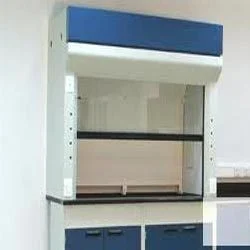Key Features:
- Ventilation System:
- Equipped with an exhaust fan that draws air from the laboratory and expels it outside or through a filtration system.
- Ensures that harmful fumes, gases, and particles are effectively removed from the workspace.
- Sash (Front Window):
- A movable glass or transparent panel that allows access to the interior while providing a barrier between the user and hazardous materials.
- Can be adjusted to control airflow and optimize containment.
- Airflow Monitoring:
- Includes airflow sensors or alarms to ensure proper ventilation and alert users if airflow is insufficient.
- Maintains consistent face velocity (typically 0.3 to 0.5 m/s) for effective containment.
- Construction Materials:
- Made from chemical-resistant materials like epoxy-coated steel, stainless steel, or polypropylene.
- Resistant to corrosion and damage from harsh chemicals.
- Types of Fume Hoods:
- Ducted Fume Hoods: Expel air outside the building through ductwork.
- Ductless (Recirculating) Fume Hoods: Use filters to clean and recirculate air back into the lab.
- Perchloric Acid Hoods: Designed for handling perchloric acid, with washdown systems to prevent explosive deposits.
- Radioisotope Hoods: Equipped with lead lining for handling radioactive materials.
- Safety Features:
- Fire-resistant construction and explosion-proof designs for handling flammable substances.
- Built-in spill containment and chemical-resistant work surfaces.
- Emergency shut-off switches and alarms for added safety.
- Energy Efficiency:
- Variable Air Volume (VAV) systems to reduce energy consumption by adjusting airflow based on sash position.
- Energy-efficient motors and fans.
Benefits:
- Protects users from exposure to harmful substances.
- Prevents contamination of the laboratory environment.
- Enhances safety and compliance with occupational health regulations.
- Provides a controlled workspace for handling hazardous materials.
| Size |
|---|
| 2×2×2 |
| 3×2×2 |
| 4×2×2 |
| 5×2×2 |
| 6×2×2 |



There are no reviews yet.